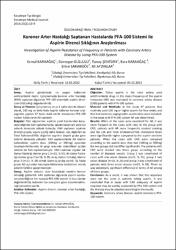Koroner arter hastalığı saptanan hastalarda pfa-100 sistemi ile aspirin direnci sıklığının araştırılması
Abstract
Amaç: Aspirin günümüzde en yaygın kullanılan
antitrombotik ilaçtır. Çalışmamızda koroner arter hastalığı
(KAH) saptanan olgularda PFA-100 sistemiyle aspirin direncinin
(AD) sıklığı değerlendirildi.
Gereç ve Yöntem: Çalışmamıza en az 4 hafta süre ile düzenli
olarak, 100 mg ve daha fazla Aspirin kullanan koroner anjiyografisi
yapılan 97 hasta dahil edildi. Hastalarda PFA-100
sistemi kullanılarak AD saptandı.
Bulgular: Tüm olgularımız aspirine yanıt bakımından karşı-
laştırıldığında KAH saptananlarda, saptanmayanlara göre AD
anlamlı derecede yüksek bulundu. KAH saptanan aspirine
dirençli grupta, sigara içiciliği daha fazlaydı, LDL değerleri ve
Total Kolesterol/HDL değerleri aspirine duyarlı gruba göre
anlamlı derecede yüksekti. KAH saptananlarda AD olanlar
kullandıkları aspirin dozu (100mg ve 300mg) açısından
karşılaştırıldıklarında iki grup arasında istatistiksel açıdan
anlamlı bir fark saptanmamıştır. KAH saptanan olgular tek
damar hastalığı olanlar grup 1 (n=21, % 35), iki damar hastalığı
olanlar grup 2 (n=16, % 26) ve üç damar hastalığı olanlar
grup 3 (n=23, % 38) olmak üzere üç gruba ayrıldı. Üç hasta
grubu AD açısından karşılaştırıldıklarında istatistiksel olarak
anlamlı farklılık saptanmamıştır.
Sonuç: Aspirin tedavisi alan hastalarda cevabın benzer
olmadığı gösterildi. KAH saptanan olgularda aspirin cevabı-
nın yeterliliğinin her hastada PFA-100 sistemi ile kısa sürede
değerlendirilip tedavinin bu sonuçlara göre düzenlenebileceği
kanaatine varıldı. Objective: Today aspirin is the most widely used
antithrombotic drug. In this study frequency of the aspirin
resistance (AR) was evaluated in coronary artery disease
(CAD) patients with PFA-100 system.
Material and Methods: In the study 97 patients that
routinely used 100 mg or higher aspirin for four weeks and
that had coronary angiographic examination were included.
In the cases with PFA-100 system AR was determined.
Results: When all the cases were examined for AR, it was
more frequent in the cases with CAD. In the group with
CAD, patients with AR more frequently smoked smoking
and the LDL and Total Cholesterol/HDL cholesterol levels
were significantly higher compared to the aspirin sensitive
patients. When the cases with CAD were compared
according to the aspirin dose they had (100mg ve 300mg)
the two groups did not differ significantly. The patients with
CAD were divided into three goups accordıng to the
number of dıseased vessels. Group 1 was constituted of
cases with one vessel disease (n=21, % 35), group 2 two
vessel disease (n=16, % 26) and group 3 was constituted of
patients with three vessel disease (n=23, % 38). There no
was statistically significant difference in terms of AR among
all three groups.
Conclusion: As a result, it was shown that the responses
were not the same in patients taking aspirin. It was
concluded that in cases with CAD adequacy of aspirin
response may be quickly evaluated by PFA-100 system and
the therapy may be adjusted according to the results
Source
Afyon Kocatepe Üniversitesi, Kocatepe Tıp DergisiVolume
15Issue
1Collections
- Kocatepe Tıp Dergisi [154]



















